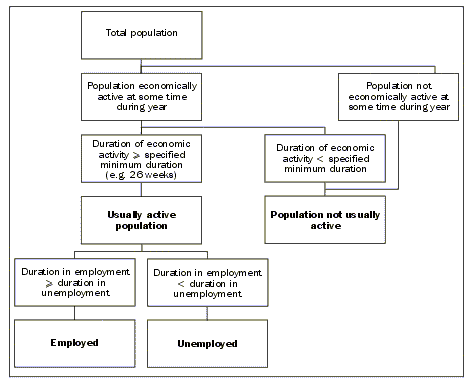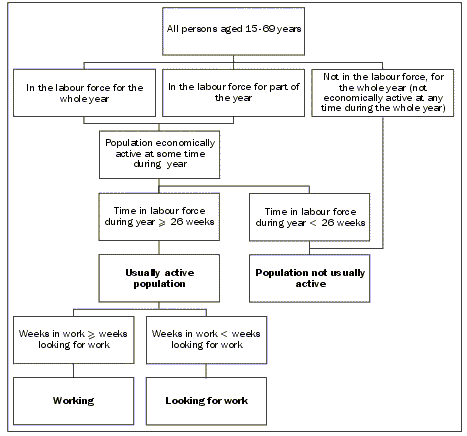Labour Statistics: Concepts, Sources and Methods was originally released in 2001 in both electronic and paper versions (cat. no. 6102.0). The paper publication will not be rereleased. However, the web version (cat. no. 6102.0.55.001) is being updated on an ongoing basis.
INTRODUCTION
9.1 As discussed in Chapter 2, there are two measures of the economically active population: the currently active population, and the usually active population. This chapter discusses the concepts and measures of the usually active population. Chapters 5 to 8 discussed concepts and measures of the currently active population.
CONCEPTS AND INTERNATIONAL GUIDELINES
9.2 International guidelines on the usually economically active population (Thirteenth ICLS 1982) recommend collection of statistics of usual activity to complement statistics of current activity. Whereas current activity measures provide a snapshot of the economically active population at a point in time, usual activity measures provide a picture of the economically active population over a long period not affected by seasonal patterns of activity, or other labour force movements. The usual activity framework permits the collection of information not only on the main activity of individuals over a long period, but also on their other activities during that period. While this measure is particularly appropriate where frequent collection of the currently active population is not practical, usual activity measures also allow for extended analysis of various aspects of labour dynamics, and of employment and income relationships. Commonly, measurement of the usually active is combined with measures of the currently active in the same survey.
9.3 The ILO, in its manual Surveys of Economically Active Population, Employment, Unemployment and Underemployment, outlines a framework for measurement of the usually active population and contrasts it with the framework of the currently active population (the labour force framework). Like the labour force framework, the usually active framework is based on activity status, and classifies the population into mutually exclusive groups of employed, unemployed and not in the labour force. However, unlike the currently active population, the framework of the usually active population is based on the main activity undertaken, and over a long rather than short reference period.
9.4 A further difference between the two frameworks concerns the order in which the economically active population and its states of employment and unemployment are determined. Within the usually active framework, individuals are first classified as 'usually active' or 'usually inactive' and then into the employed and unemployed categories. In contrast, in the labour force framework individuals are first identified as employed or unemployed (which together form the labour force, the measure of the current stock of labour supply).
LONG REFERENCE PERIOD
9.5 The international guidelines recommend the use of a long reference period for measurement of the usually economically active population, such as 12 months. The international guidelines consider a range of survey situations where the use of either a fixed or moving reference period may be appropriate, and suggest that for countries where the survey data are collected over a short period (as in Australia) a fixed reference period is preferable.
MAIN ACTIVITY STATUS
9.6 According to the international guidelines, the usually active population comprises all persons above a specified age whose main activity status, as determined in terms of number of weeks or days during a long specified period, was employed or unemployed as defined in the labour force framework.
9.7 The framework for usual activity recommended by the ILO is shown in diagram 9.1.
9.1 ILO FRAMEWORK OF USUAL ACTIVITY

DEFINITIONS USED IN ABS SURVEYS
9.8 Measures of the usually active population are collected by the ABS in the supplementary topic to the Labour Force Survey, Labour Force Experience. The concepts and definitions underlying measures from this survey are outlined below.
9.9 The survey collects information about time spent in labour force activities, including episodes of looking for work and time spent out of the labour force, over a 12 month period. Measures of 'worked' and 'looked for work' collected in the survey are based on the respondents' own perception of their labour force status.
9.10 The survey classifies persons into various labour force states during the survey year based on a more limited set of questions than is used in surveys of the currently active. Accordingly, the terms 'worked' and 'looked for work' are used rather than the more precisely defined 'employed' and 'unemployed'. While this approach is not consistent with the international guidelines, the ILO recognises that measuring employment and unemployment as defined in the labour force framework over a long reference period may not be practical (as they depend on respondent recall in relation to retrospective measures).
9.11 The survey publication Labour Force Experience, Australia (cat. no. 6206.0) presents a framework for the Labour Force Experience Survey which groups the population into three mutually exclusive groups. Using these three groups as a starting point, a framework for determining the usually active/inactive split that aligns with the international guidelines can be constructed:
- The first group, 'in the labour force for the whole year', corresponds to usually active (either employed or unemployed depending on the labour force state in which most time was spent).
- The second group, 'in the labour force for part of the year', corresponds to either usually active or usually inactive depending on the duration of time spent in the labour force. Persons in this group who spent the majority of the 12 month reference period working correspond to usually active 'employed'. Those who spent the majority of the period looking for work correspond to usually active 'unemployed'. Those who spent the majority of the period not in the labour force (neither working nor looking for work) correspond to usually inactive.
- The third group, 'not in the labour force for the whole year', corresponds to usually inactive.
9.12 These concepts are illustrated below in diagram 9.2.
9.2 ABS FRAMEWORK FOR DETERMINING USUAL ACTIVITY (AN EXTENSION OF THE LABOUR FORCE EXPERIENCE SURVEY FRAMEWORK)

DATA SOURCES
9.13 Information about the usually economically active population is available from:
- the supplementary topic to the Labour Force Survey, Labour Force Experience, and various other supplementary topics;
- Special Social Surveys; and
SUPPLEMENTARY SURVEY: LABOUR FORCE EXPERIENCE
9.14 The primary ABS data source for the usually active population is the supplementary survey to the Labour Force Survey, the Labour Force Experience Survey. This topic classifies persons into the various labour force states using the framework outlined above. For further information on the content or methodology of this survey refer to Chapter 21.5.
OTHER SUPPLEMENTARY SURVEYS
9.15 Other supplementary surveys that collect more detailed information on subgroups within the usual activity framework include: the Labour Mobility Survey, which collects information from persons who had worked during the 12 months prior to the survey reference date; and the Successful and Unsuccessful Job Search Experience Survey, which collects information from persons who had looked for work during the 12 months prior to the survey reference date. For further information on both these surveys, see Chapter 21.7 and Chapter 21.13.
SPECIAL SOCIAL SURVEYS
9.16 The Special Social Survey, the Survey of Employment and Unemployment Patterns also used the concepts of the usual activity framework, as outlined above, to classify persons into various 'episodes of labour market activity' which included: working; looking for work; and absence from the labour market. For further information on the content and methodology of this survey, see Chapter 24.
LABOUR FORCE SURVEY
9.17 The Labour Force Survey collects related information in its quarterly measures of job tenure (length of time in current job) and employment expectations, thus providing complementary measures of labour market dynamics in the form of recent and potential future movements in the labour force, and a broad measure of the extent of short-term employment. For further information on the content or methodology of this survey refer to Chapter 20.
FURTHER INFORMATION
9.18 For further details contact the Labour Market Statistics Section, on Canberra (02) 6252 7206.
 Print Page
Print Page
 Print All
Print All